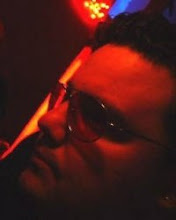Not to diminish the timelessness of the early surrealist masters but I doubt that the unconscious landscape of the 21C dreamer bares likeness to Dali's endless deserts or the marble columned corridors of De Chirico. I would suggest, instead, that if you took a snapshot of the contemporary unconscious the setting would resemble the brightly hued, leisure among the ruins of Chloe Early or the dark, deconstructed down to geometric grid, urban landscapes of Ian Francis.
Much of the work in Francis' New York solo debut, Fireland, inhabits an uneasy twilight areas between the unconscious and the urban street. In High Angle Deer Park (above), an urban park is stripped and flattened into a grid pattern forming an abstracted game board where a mysterious competition/ritual underway bathed with sexual tension and submerged violence.
In the striking Three People Lose Track of Time in the Financial District of San Francisco (below) the urban street is reduced to a series of streaked and tarnished geometric forms. What we can assume is a busy city street is depopulated leaving only the three narrative figures. The title places the scene in a specific location while the actual image is devoid of identifiable locative cues. Instead the figures inhabit a peculiar limbo, simultaneously in public and removed to a place of safety where internal life is free to manifest.
Again only a teasing suggestion of narrative is discernible. The viewer is positioned as an uninformed voyeur spying on a private emotional moment. The emotions are familiar but the specifics of the situation are a mystery. The figures appear familiar enough yet their forms are fantastic. They are more changeable composites than studied likenesses. Facial detail conveys raw emotion, the intimate confusion of the female figures, the anguish of the male figure carry a certain weight, however the figures are unstable, their faces extending in multiple, legs fading into the background. They are vaporous inhabitants of dreamspace where all things, even people, are shrouded in occult meaning but that meaning is fluid, uncertain and beyond concise explanation.
There is a connection to be made here between these urban landscapes, stripped down and re-mapped for unconscious exploration and the growing prevalence of augmented reality. However, I can not at this moment string the ideas together. It does seem, however, that there is insight to gleaned from the juxtaposition of the fantastic landscapes of Dali and De Chirico and these more contemporary abstracted urban scenes. Is it that the urban landscape has become so abstract, so removed from the "natural" world, so wiped clean through excess stimuli, that they are now the blank canvas for out waking dreams? On the other hand could it be that we have become so removed from any sense of uninfluenced imagination that our unconscious mind can no longer build the pristine deserts of surrealist fantasy? Instead we are left to simply augment the everyday world, creating just enough space to dream but perhaps not enough space to dream large.
Ian Francis: Fireland is up at Joshua Liner Gallery until April 2.





